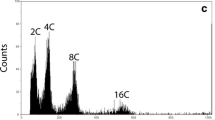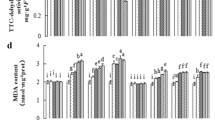Abstract
Phosphite (H2PO3 −, Phi) prevents the acclimation of plants and yeast to orthophosphate (Pi, HPO4 2−) deprivation by specifically obstructing the derepression of genes encoding proteins characteristic of their Pi-starvation response. In this study, we report that prolonged (i.e., 3–4 weeks) culture of Brassica napus L. suspension cells in Pi-deficient (−Pi) media leads to programmed cell death (PCD). However, when the B. napus cells were subcultured into −Pi media containing 2 mM Phi, they initiated PCD within 5 days, with 95% cell death observed by day 9. Dying cells exhibited several morphological and biochemical features characteristic of PCD, including protoplast shrinkage, chromatin condensation, and fragmentation of nuclear DNA. Immunoblotting indicated that B. napus cells undergoing PCD upregulated a 30-kDa cysteine endoprotease that is induced during PCD in the inner integument cells of developing B. napus seeds. It is concluded that PCD in B. napus suspension cells is triggered by extended Pi starvation, and that Phi treatment greatly accelerates this process. Our results also infer that the adaptive value of acclimating at the molecular level to Pi-stress is to extend the viability of −Pi B. napus cell cultures by about 3 weeks.






Similar content being viewed by others
Abbreviations
- APase:
-
acid phosphatase (EC 3.1.3.2)
- BnCysP:
-
B. napus cysteine proteinase
- DAPI:
-
4′,6′-diamidino-2-phenylindole
- FDA:
-
fluorescein diacetate
- PCD:
-
programmed cell death
- Phi:
-
phosphite
- +Pi and −Pi:
-
Pi-sufficient and -deficient, respectively
- PI:
-
propidium iodide
- PSI:
-
Pi-starvation inducible
References
Abel S, Ticconi CA, Delatorre CA (2002) Phosphate sensing in higher plants. Physiol Plant 115:1–8
Beers EP, Woffenden BJ, Zhao C (2000) Plant proteolytic enzymes: possible roles during programmed cell death. Plant Mol Biol 44:399–415
Bollag DM, Rozycki MD, Edelstein SJ (1996) Protein methods. Wiley–Liss, New York, pp 62–70
Carswell MC, Grant BR, Niere J, Theodorou ME, Plaxton WC (1996) The fungicide phosphonate disrupts the phosphate starvation response of Brassica nigra seedlings. Plant Physiol 110:105–115
Carswell MC, Grant BR, Plaxton WC (1997) Disruption of the phosphate-starvation response of oilseed rape suspension cells by the fungicide phosphonate. Planta 203:67–74
De Jong AJ, Hoeberichts FA, Yakimova ET, Maximova E, Woltering EJ (2000) Chemical-induced apoptotic cell death in tomato cells: involvement of caspase-like proteases. Planta 211:656–662
Devaux C, Baldet P, Joubès J, Dieuaide-Noubhani M, Just D, Chevalier C, Raymond P (2003) Physiological, biochemical and molecular analysis of sugar-starvation responses in tomato roots. J Exp Bot (in press)
Foerster H, Adaskaveg JE, Kim DH, Stanghellini ME (1998) Effect of phosphite on tomato and pepper plants and on susceptibility of pepper to Phytophthora root and crown rot in hydroponic culture. Plant Dis 82:1165–1170
Guest D, Grant BR (1991) The complex action of phosphonates as antifungal agents. Biol Rev 66:159–158
Hoeberichts FA, Orzaez D, van der Plas LHW, Woltering EJ (2001) Changes in gene expression during programmed cell death in tomato cell suspensions. Plant Mol Biol 45:641–654
Jones KH, Senft JA (1985) An improved method to determine cell viability by simultaneous staining with fluorescein diacetate–propidium iodide. J Histochem Cytochem 33:77–79
Krishnamurthy KV, Krishnaraj R, Chozhavendan R, Christopher FS (2000) The programme of cell death in plants and animal — a comparison. Curr Sci 79:1169–1181
McCabe PF, Leaver CJ (2000) Programmed cell death in cell cultures. Plant Mol Biol 44:350–368
McDonald AE, Grant BR, Plaxton WC (2001a) Phosphite (phosphorous acid): its relevance in the environment and agriculture, and influence on the plant phosphate starvation response. J Plant Nutr 24:1505–1519
McDonald AE, Niere JO, Plaxton WC (2001b) Phosphite disrupts the acclimation of Saccharomyces cerevisiae to phosphate starvation. Can J Microbiol 47:969–978
Mlejnek P, Procházka S (2002) Activation of caspase-like proteases and induction of apoptosis by isopentenyladenosine in tobacco BY-2 cells. Planta 215:158–166
Moraes TF, Plaxton WC (2000) Purification and characterization of phosphoenolpyruvate carboxylase from Brassica napus (rapeseed) suspension cell cultures. Implications for phosphoenolpyruvate carboxylase regulation during phosphate starvation and the integration of glycolysis with nitrogen assimilation. Eur J Biochem 267:4465–4476
Pennel RI, Lamb C (1997) Programmed cell death in plants. Plant Cell 9:1157–1168
Plaxton WC (1999) Metabolic aspects of phosphate starvation in plants. In: Deikman J, Lynch J (eds) Phosphorus in plant biology: regulatory roles in molecular, cellular, organismic, and ecosystem processes. ASPP, Rockville, MD, pp 164–176
Rickard DA (2000) Review of phosphorous acid and its salts as fertilizer materials. J Plant Nutr 23:161–180
Smith CR, Knowles VL, Plaxton WC (2000) Purification and characterization of cytosolic pyruvate kinase from Brassica napus (rapeseed) suspension cell cultures. Implications for the integration of glycolysis with nitrogen assimilation. Eur J. Biochem 267:4477–4485
Swidzinski JA, Sweetlove LJ, Leaver CJ (2002) A custom microarray analysis of gene expression during programmed cell death in Arabidopsis thaliana. Plant J 30:431–446
Ticconi CA, Delatorre CA, Abel S (2001) Attenuation of phosphate starvation responses by phosphite in Arabidopsis. Plant Physiol 127:963–972
Varadarajan DK, Karthikeyan AS, Matilda PD, Raghothama KG (2002) Phosphite, an analog of phosphate, suppresses the coordinated expression of genes under phosphate starvation. Plant Physiol 129:1–9
Wan L, Xia Q, Selvaraj G (2002) Early stages of seed development in Brassica napus: a seed coat-specific cysteine proteinase associated with programmed cell death of the inner integument. Plant J 30:1–10
Acknowledgements
We are very grateful to Drs. Steven Huber (USDA Plant Science Research, North Carolina State Univ.), Paul McCabe (Dept. of Botany, Univ. College Dublin), and Phillipe Raymond (Unité Mixte Rech. Physiol. Biotech. Vég., Centre de Recherché de Bordeaux) for helpful discussions, to Drs. William Newcomb and Paul Young (Dept. of Biology, Queens Univ.) for providing microscopy facilities, and to Dr. Gopalan Selvaraj (Plant Biotech. Inst, National Research Council of Canada) for the gift of rabbit anti-(BnCysP) immune serum. Financial support was generously provided by research and equipment grants from the Natural Sciences and Engineering Research Council of Canada (NSERC).
Author information
Authors and Affiliations
Corresponding author
Rights and permissions
About this article
Cite this article
Singh, V.K., Wood, S.M., Knowles, V.L. et al. Phosphite accelerates programmed cell death in phosphate-starved oilseed rape (Brassica napus) suspension cell cultures. Planta 218, 233–239 (2003). https://doi.org/10.1007/s00425-003-1088-2
Received:
Accepted:
Published:
Issue Date:
DOI: https://doi.org/10.1007/s00425-003-1088-2




